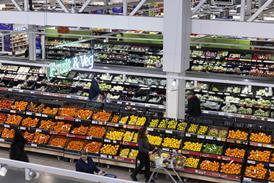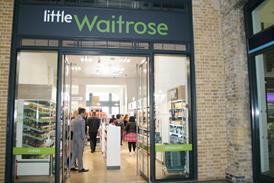Why then has the £580m market slowed in the last year, dropping back from double digit growth in 2000 to a meagre 3% rise in the 52 weeks to the end of September?
The culprit is frozen pizza, traditionally the market's driver, which has taken a 3% tumble its first decline since the category's inception. The reason is two-fold.
Value has been taken out of the frozen sector by the huge number of promotions, many of them deep cut, which have escalated in the last year. Heinz frozen & chilled brand manager Hannah Livesley reckons more than 50% of frozen pizza is sold on deal, and as much as 60% in some sectors, such as snacking.
The impact can be seen in TNS Superpanel's figures, which show volume has fallen slightly less than value. The 9-inch pizza has suffered the most, virtually becoming a commodity sector, with price points as low as 49p for a basic tomato & Edam cheese product produced by Freiberger for Asda and Tesco own labels.
More serious is consumers' dissatisfaction with frozen pizza. Green Isle category marketing controller Stephen Kimber says this stems from manufacturers diverting resources into heavy discounting. "The pressure for continued discounting has forced brand owners to accept increasingly smaller margins, squeezing their investment in new product development. In some cases it's even led to a drop in product quality. Our research shows consumers are dissatisfied by poor bases and insufficient toppings," he says.
Heinz's Livesley says the quality issue has resulted in penetration falling by an estimated 100,000 households.
Chilled pizza has reaped the benefits of this defection. This sector has grown 13%, a remarkable performance considering it is virtually all own label and consequently sees very little advertising, one of the principal mechanisms for stimulating trial and sales.
Asda pizza buying manager Tim Cullum has a firm view on why chilled is performing so well. "It's down to quality, choice and delivery when cooked. You get a better eat with fresh and it's never soggy, which it can be with frozen. Also, people have a better perception of chilled food than frozen."
Asda's everyday low pricing strategy has achieved huge volume growth plus an increased share of trade for chilled pizza, as Cullum explains. "The market has moved up, but we've reduced prices and are continuing to hold them, even though some raw material costs have risen. Our everyday pizza price is £1.59, compared to £1.98 for the market average."
As deep cuts are out, Asda's promotional strategy is built on permanent link-saves, such as three 9-inch thin & crispy pizzas for £5. "Our big seller is the 15-inch stone baked pizza which we do as a family deal with 2 litres of Coca-Cola and garlic bread for £4.50," says Cullum.
Another factor in the chilled sector's performance is the development and growth of higher value premium pizzas, a trend that's really emerged in the last year.
"We're seeing a move to premiumisation, with the development of Pizza Express type products and Extra Special from Asda," says Cullum. "Bases are stone baked and toppings are becoming more authentic and of higher quality, with ingredients such as buffalo mozzarella, chorizo and fine Italian hams. It's pushed prices up. Eight months ago you wouldn't have seen anything over £3.50, now you're seeing premium products at £3.89 and even over £4."
Asda's Extra Special premium range has seen triple digit growth, says Cullum.
Own label chilled pizza manufacturer Stateside sees the greatest potential coming from the premium sector, particularly stone baked products appealing largely to adults. Sales and marketing director Guy Sabini says stone baking replicates the authentic Italian restaurant quality that consumers are increasingly demanding.
"We were the first to set up stone baked production. This is where growth has come from in the last two years and where it will come from in the future. Multipacks have contributed significantly to encouraging consumer trial of these products.
"More authentic toppings such as prosciutto, chargrilled vegetables and spinach and ricotta are becoming increasingly popular. Deep pan and thin and crispy still remain the core of the chilled sector, but they don't have as much potential," Sabini says.
Hazlewood Foods, the other leading own label producer, has just opened one of the UK's largest chilled pizza factories in the UK at Deeside to capitalise on chilled's growth. Pizza category marketing controller Jane McCarthy says developments such as Sainsbury's Taste the Difference pizza range has proved that consumers are looking for something new and different, and are prepared to pay for premium products. "Premium pizzas also bring new users to the market, attracting ABs in the 25-40 age group who have higher expectations and like to eat out."
The company is now working on developments that fill market gaps it has identified and which fall in with current eating trends. McCarthy says these include indulgence, lighter and healthier eating, organic and food to go.
One of the most interesting developments is the debut of Bernard Matthews, until last month a pizza market outsider, which has now entered the chilled sector with a brand offering, Pizzahhhh.
Product manager Kim Burgess says the company hopes to replicate in chilled pizza the success it has had with its brand in sliced cooked meats, another own label dominated area. "We're looking to stretch," says Burgess, "and we feel chilled pizza could do with a brand. It also provides another opportunity to use our cooked meats."
Bernard Matthews has gone for 9-inch main meal pizzas, an area it believes has the most potential, with three products that it claims have 50% more topping than the average pre-packed pizza. The flavours buck the trend for authenticity, as they include turkey tikka with an Indian style sauce and smoked turkey ham with cheese. Burgess agrees they are unusual, but says they were the most popular choices in consumer taste tests. "Turkey tikka does not have cheese, so will appeal to people who don't like or can't eat cheese," she adds. The company will also score by being the first brand to support chilled pizza with national TV advertising next year.
Battered and squeezed by falling sales values, frozen pizza manufacturers are starting to redress consumers' poor perception of frozen pizza. Green Isle and Heinz are making substantial investments in innovation and product quality to revitalise the sector.
Last month Green Isle introduced Goodfella's Stone Baked Ciabatta Style Pizza, a product which mirrors those found in chilled, with a base made with extra virgin olive oil. Geared to adult tastes, it comes in four classic varieties at rsp £2.39, with a trial price of £1.79. "It is restaurant quality," says Green Isle's Kimber, "and the trade's response has been fantastic."
The company has built a £20m production plant in Ireland to manufacture the new pizza and is spending £7m on marketing it, including a new TV commercial that began this month.
The introduction is timely, for stone-baked products are a growing trend in frozen as well as chilled. Freiberger general sales manager Andy Thorne says more than 90% of its own label business is stone baked, with sales growing 25%.
Green Isle's development is matched by Heinz which recently launched Pizza-Pleasure, a 9-inch main meal pizza with a light and crispy base in five classic varieties with generous toppings Ultimate Pepperoni has a triple layer of pepperoni. Rsp is £2.19-£2.39. Heinz's Livesley says: "These products are adult focused and deliver on quality, so we are confident they will overcome the frozen pizza barriers."
Pizza-Pleasure is being given a massive launch, with Heinz spending £10m on support, including TV advertising that began last month.
The company is also investing in its San Marco brand in the shape of an on-pack offer for Heinz Salad Cream on the twin-pack variant.
Twin packs is one of the few areas of growth in frozen pizza (up 23% in value/volume), led by Schwan's Chicago Town, the biggest brand in frozen with 20.9% share and 29% y-o-y growth.
Schwan's European marketing controller Ben Johnson says twin-packs' success is due to offering consumers good value, a point the company reinforces on its 9-inch Chicago Town which is price marked £3.18 for two pizzas. The twin-pack strategy has significantly increased weight of purchase 23% of households now have pizza in the freezer, says Johnson which the company plans to increase further with a 5-inch deep dish 4-pack at £2.98 in Tesco and Iceland, plus a new thin & crispy variant, Classic, which went into store this month, price marked £2.98 for two.
Its bake and rise Freschetta brand has grown 5%, pushing its share to 5.7% of the frozen market.
Johnson attributes Schwan's performance a 27% share of the frozen market which raised its market stake by 33% to its studies of consumer needs and its ability to respond to them. Its latest study shows pizza is bought mainly for convenience and as a treat. "We are working with retailers to capitalise on this with impulse sitings next to tills and the beers, wines and spirits fixture," says Johnson.
McCain has championed the convenience snack aspect with its microwaveable Micro Pizza range which has gained a stable 5% share. It has taken the concept further with Pizza Fingers, which are bite size slices aimed at children.
{{FOCUS SPECIALS }}
Close menu
- Home
- Buying & Supplying
- Stores
- Channels
- Finance
- People
- Reports
- Events
- Jobs
- Subscribe now
Sign in to comment on this article
Not logged in before? Register for FREE guest access today.
You will be able to:
- Read more stories
- Receive daily newsletters
- Comment on stories
Advert











No comments yet